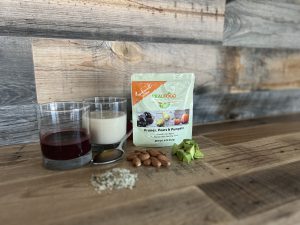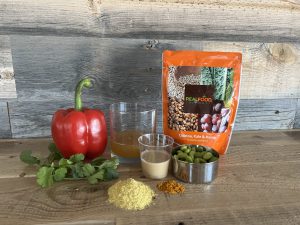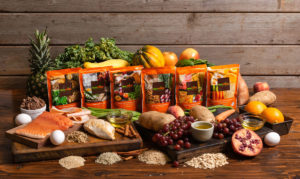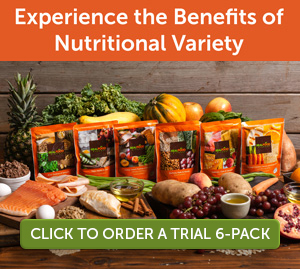Navigating Plant-Based Blended Tube Feeding: What to Look For and What to Include
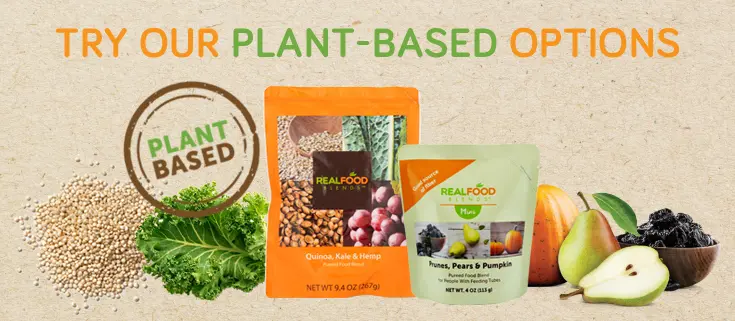
Navigating Plant-Based Blended Tube Feeding: What to Look For and What to Include by Hilarie Dreyer RD, CSP
With plant-based commercial products like Real Food Blends Quinoa Kale and Hemp pouch and Real Food Blends Mini, and the ability to blend food at home for tube feeding it is now simpler for those requiring tube feeding to meet their dietary preferences and nutrition goals with a plant-based approach.
As a Registered Dietitian and passionate advocate of blended tube feeding, it’s important to me to give those fed via feeding tube choice back in how they nourish themselves, while also respecting their beliefs and preferences.
Therefore, this article is not meant to advocate for any one specific diet. Rather, its purpose is to provide necessary information to make informed choices when following a plant-based blended tube feeding diet.
A Plant-Based Approach for Blenderized Diets: What Does It Look Like?
People who follow a plant-based diet tend to prioritize eating foods like fruits, vegetables, whole grains, beans, legumes, nuts, and seeds, and may limit or omit certain animal products such as meat, fish, eggs, and dairy.
There are many variations of this diet and it can look different from person to person. Some may opt for a strictly vegan diet, while others may opt to incorporate plant-based meals only on certain days of the week.
And guess what, it is the same for tube feeding! After all, for most people a feeding tube is just another way to get nutrients into the body.
Whether you eat by mouth or through a feeding tube, there are a few things to consider when following a plant-based diet. This article will review what nutrients might be missing, and how to incorporate them into your blended meals so you can maintain optimal health.
And because I’m all about making the blending process as simple as possible, I’ll be offering tips and tricks along the way, such as using ready-made products like Real Food Blends to save time on meal preparation. And don’t miss the sample one-day blended diet meal plan at the end!
Important Nutrients on a Plant-Based Blended Diet
Protein:
Protein is super important for keeping our bodies running smoothly, as well as building and maintaining muscle and bones. Animal-based proteins are especially great as they give us all the essential amino acids (building blocks of protein) that our bodies need.
Plant-based proteins don’t usually provide all the essential amino acids in the right amounts, but if you mix and match different plant-based foods, you can get the amino acids your body needs.
Here are some of my favorite plant-based protein sources for a blended diet:
- Tempeh
- Edamame
- Tofu
- Lentils
- Nuts and Seeds
Blended Tube Feeding Tips: Lentils thicken up blended meals quickly. I suggest starting with a small amount to avoid an overly thick meal.
Iron
Iron is important for our bodies and plays a role in oxygen transport. It does this through a special protein called hemoglobin found in our red blood cells. This oxygen delivery is important for our energy levels, keeping our cells healthy, and supporting our immune system.
If you’re looking to get enough iron on a plant-based diet, it can be a little tricky. This is because the kind of iron found in plant foods is not as easily absorbed as other types. To ensure your body is taking in the most iron possible, combine iron-rich foods with those high in vitamin C, such as oranges and strawberries.
Here are some of my favorite plant-based iron sources for a blended diet:
- Spinach and Swiss Chard
- Kidney Beans and Lentils
- Fortified Cereals
- Blackstrap molasses
- Tofu
Blended Tube Feeding Tips: Real Food Blends Quinoa Kale and Hemp packet contains 7 mg of iron in one packet! Blending in a citrus fruit or juice will help your body absorb the iron and get the most out of your meal.
Vitamin B12
Vitamin B12 is important to keep your brain, heart, muscles, and nerves healthy. Unfortunately, our bodies do not make B12 on their own so we need to get it from food or supplements. Those following a plant-based diet must pay special attention to vitamin B12, as it is only found naturally in animal foods.
Here are some of my favorite plant-based vitamin B12 sources for a blended diet:
- Fortified Nutritional Yeast
- Fortified Plant-Based Beverages (coconut, almond, oat, pea, rice and soy milks)
- Fortified Plant-Based Meat Alternatives
- Fortified Cereals
Blended Tube Feeding Tips: Adding fortified nutritional yeast to blended meals is an excellent way to add calories and get a good dose of vitamin B12. There are many shelf-stable options available, making it a pantry staple for those on a plant-based blended diet.
Vitamin D
Vitamin D is essential for healthy bones, a functioning immune system, and keeping nerves and muscles in good shape. Unfortunately, getting enough of it can be tricky. Fish and seafood are great sources of vitamin D, but otherwise it is not present in many foods, and it’s hard to get enough year-round sunshine (trust me, I live in Michigan and know the feeling!)
Here are some of my favorite plant-based vitamin D sources for a blended diet:
- Fortified Breads and Cereals
- Fortified Orange Juice
- Fortified Plant-Based Beverages
- Mushrooms (Exposed to UV Light – Labeled as Such on the Package)
Blended Tube Feeding Tip: Families I work with often opt for fortified plant-based beverages as the liquid base in blended meals to increase calories. In order to create high calorie, low volume meals, look for a plant-based beverage with at least 130 calories per 8 ounce serving.
Calcium
If you want to help keep your bones strong and support nerve and muscle health, it’s important to make sure that calcium is a part of your diet. Animal-based foods, like milk and yogurt, contain a lot of calcium and are easier for the body to absorb than plant-based calcium sources.
If you’re following a plant-based diet, don’t stress – there are many foods that are packed with calcium that are perfect for tube feeding. Try adding several of these nutrient-rich foods to your blended meals throughout the day to ensure you’re getting the calcium you need.
Here are some of my favorite plant-based calcium sources for a blended diet:
- Tofu in Calcium Sulfate Brine
- White Beans and Navy Beans
- Seaweed and Kelp
- Fortified Cereals and Oats
Blended Tube Feeding Tip: Tofu is a great addition to blended meals! It blends easily and is nutrient dense. Look for tofu in calcium sulphate, a commonly used coagulant in making tofu.
Zinc
Zinc is an important micronutrient that helps keep your immune system in tip-top shape! It also is vital for the proper functioning of the human body, in general.
Zinc can be acquired from both plant and animal-based foods, however it is less easily absorbed in plant-based sources than animal based-sources.
Here are some of my favorite plant-based zinc sources for a blended diet:
- Wheat Germ
- Hemp Hearts
- Fortified Cereals
- Pumpkin Seeds
Blended Tube Feeding Tip: If you’re looking for a calorie-rich way to amp up your blended meals, look no further than hemp hearts! Just 3 tablespoons can give you approximately 180 calories, depending on the brand, and you can usually find them in the baking aisle of your local grocery store!
Omega-3 Fatty Acids
Omega-3 fatty acids are essential for keeping your heart healthy. It can be difficult to get enough omega-3 on a plant-based diet as the main sources are found in animal products such as fish and eggs. You can get some of your omega-3 from plant sources like walnuts, chia seeds and flaxseeds. It is important to talk to your health care team about omega-3 supplements if you follow a strictly plant-based diet.
Your Recommended Nutrient Needs
Figuring out your nutritional needs can be daunting. Everyone’s needs vary, and it can be hard to track down reliable info. If you want to get a head start, the Dietary Guidelines for Americans is a great resource. When you’re ready, however, it’s best to consult with a dietitian or health care team to get your exact requirements.
Sample One-Day Plant-Based Meal Plan
If you’re looking for inspiration for your tube feeding regimen here is a sample plant-based meal incorporating Real Food Blends. The recipes are easy to follow and packed with nutrients!
Real Food Blends provides an easy way to incorporate real food into your tube feeding routine, without having to make every meal from scratch!
- Breakfast: ½ Acai Smoothie Bowl with Real Food Blends Mini recipe (250 mL)
- Lunch: 1 pouch Real Food Blends Quinoa, Kale & Hemp (240 mL)
- Snack: 1 pouch Real Food Blends Mini Prunes, Pears & Pumpkin (100 mL)
- Dinner: ½ Edamame Salad with Tahini and Real Food Blends Quinoa recipe (225 mL)
Provides: Approximately 1160 calories, 37 grams protein
Please note, this is simply a one-day meal plan and is not meant to be primary source of nutrition. Consult with your medical team before making any changes to your diet. If micronutrients are a concern, a 100% complete multivitamin can be a simple solution, and if needed an additional calcium supplement and sodium per clinician recommendation.
Recipes:
- 1 pouch Real Food Blends Mini Prunes, Pears & Pumpkin
- 1 acai smoothie packet (3.5 oz)
- 1 slice avocado (~1/8 avocado)
- 1 Tbsp hemp hearts
- 1/4 cup almonds
- 2 Tbsp honey
- 1 cup extra creamy oat milk
Add food and liquid to the blender and blend on high for ~2 minutes, or until completely liquified and with no chunks. You may need to strain the blended meal if there are any pieces/chunks.
This yields ~500 mL, with approximately 740 calories (1.5 calories per mL) and 15 g of protein for full recipe. This will make enough for 2 servings. Store unused portion in refrigerator for up to 24 hours. However, the exact nutritional content may vary by brand or type.
Edamame Quinoa Salad with Tahini
- 1 pouch Real Food Blends Quinoa, Kale & Hemp
- 1/4 cup edamame
- 1/4 cup red pepper, raw
- 1/4 cup cilantro, raw
- 3 Tbsp tahini*
- 2 Tbsp nutritional yeast
- 1/2 tbsp turmeric, ground
- 1/4 cup vegetable broth
Add food and liquid to the blender and blend on high for ~2 minutes, or until completely liquified and with no chunks. You may need to strain the blended meal if there are any pieces/chunks.
This yields ~450 mL, with approximately 725 calories (1.6 calories per mL) and 33 g of protein for full recipe. This will make enough for 2 servings. Store unused portion in refrigerator for up to 24 hours. However, the exact nutritional content may vary by brand or type.
*Contains sesame.
I hope this article has been helpful to you, and that you will enjoy making these nutritious blended meals for either yourself or your tube fed loved one!
Happy Blending,
Hilarie, RD, CSP
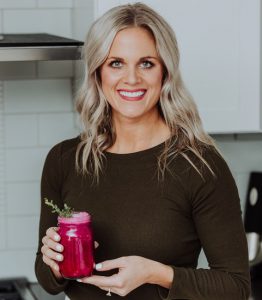
Navigating the Holidays in 2020

Navigating the Holidays in 2020
How to focus on what matters most during this unusual time

Create new traditions. Sticking with old traditions is great, but this is also a perfect time to create new ones. Maybe it’s a holiday movie night at home with festive pajamas and your favorite movies. For those who love crafts, you could make a special ornament or holiday decoration together as a family. To give back, you could spend an evening writing cards for seniors at a local nursing home or shopping online for Toys for Tots or any other organization that takes gift donations during this time of year. Celebrate the freedom of new traditions and focus on activities that your loved one with a feeding tube can participate in and enjoy. New traditions that you start this year might just become some of your family’s favorite holiday activities every year.
Adjust old traditions. Old traditions can still be modified to make sense this holiday season. If your family usually does a gift exchange, change it up to a gift delivery where everyone drops presents off (or has them shipped) and then set a date for a Zoom call to keep the fun of opening presents together. Baking and cooking are big for many families during the holidays, and getting together through a video call and cooking and baking the same recipe is a great way to keep up this tradition. Including your loved one with a feeding tube in these traditions is just as important this year, whether it’s helping make the recipe or just joining in on the video call. Adapting beloved traditions allows for a sense of normalcy that is especially needed this holiday season.
Let go of what doesn’t work. Not all traditions will make sense this holiday season, and that’s OK. Big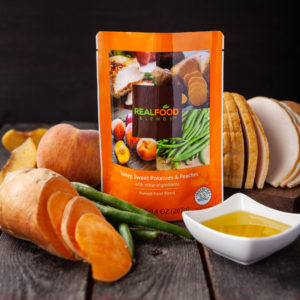
Staying positive during these tough times and creating new memories will help make this holiday season just as special as any other year. In many ways, the only thing we can control right now is our attitude toward an ever changing reality — something that families with special needs certainly have experience with. Although the holidays may not look exactly the same this year, the love and joy you feel when you know your family is happy and healthy overcomes everything else.
Do You Really Need a Peptide Formula?
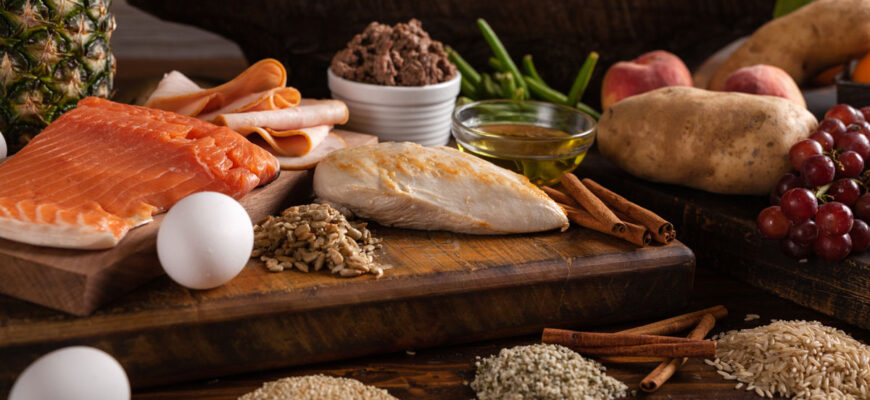
Do You Really Need a Peptide Formula?
The basics about peptides, when they should be used, and why to consider food first
by April Jackson, MS, RD, LDN, CNSC
Even with growing support for real food for people with feeding tubes, most people with feeding tubes are still put on standard (read: cheapest!) commercial formula when they first get a feeding tube. While these formulas can literally be lifesaving, GI-related intolerance symptoms are quite common. Several studies report the incidence of GI intolerance to be as high as 75%, especially in hospitalized patients.1 2 3 These intolerance symptoms include nausea, vomiting, diarrhea, constipation, retching, and reflux.
So what’s the standard treatment when a patient is having intolerance symptoms to a regular formula? The “old way” of treating side effects looks like this:
1. Prescribe medications to treat side effects. A recent review of hospitalized patients with feeding tubes noted that more than 37.9% of patients received a medication to stimulate stomach emptying and 13.4% of patients received more than one of these medications while on tube feedings.1
The need for these medications should really be examined, especially in situations where a patient hasn’t needed them as an oral eater, but now does when fed formula-only through the tube.
2. Next, switch to a lower rate of feeding (either via gravity or pump) to treat GI intolerance symptoms related to volume intolerance or dumping syndrome.
If a person is being fed one synthetic formula as their only nutrition, and that’s causing diarrhea 50% of the time, does it make sense to keep feeding that one formula as the only source of nutrition, just slower and over more hours? Imagine giving that advice to an oral eating person!
3. Another common approach for clinicians is to switch the patient from standard formula to a peptide-based formula to see if this is better tolerated. If a peptide formula isn’t tolerated, the patient is often moved to an elemental formula.
Is the form of protein really the problem? Comparing ingredient lists of a standard formula to a peptide formula, are they really THAT different?
What Exactly is a Peptide Formula?
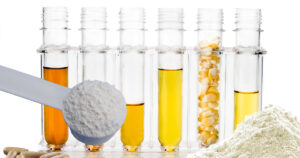
Elemental formulas, the next step in the typical enteral formula algorithm, contain proteins that are 100% broken down into amino acids. Amino acids are the building blocks of protein that are essential for growth and development. These formulas are considered hypoallergenic and are recommended for those with milk or soy protein allergies, food protein intolerances or allergies like Eosinophilic esophagitis, and severe malabsorption.
These specialized formulas were created for people who are unable to digest real food, or with severe allergies. If the patient has eaten regular food prior to the tube being placed, or the tube was placed due to the inability to safely eat orally, do they truly need a specialized formula?
What Does the Research Say About Peptides?
Limited research exists comparing the use of standard formulas to peptide formulas, and the data is conflicting in the research that is available. Because of this, the use of peptide and elemental formulas is based on expert opinion (Grade E).5 Some evidence suggests that peptide formulas may be helpful with very specific patients, such as those with malabsorption or pancreatic dysfunction or to allow prolonged bowel rest following major abdominal surgery or other evidence of GI disease.6 However, other studies have shown little to no difference in tolerance between standard and peptide formulas.5 6 7 8.
A recent study showed improved tolerance using peptide-based diets in patients at risk for significant malabsorption because of GI surgery or pancreatitis.9 Even with this study, however, 56 percent (30/53) of patients continued to experience nausea, vomiting, diarrhea, abdominal pain/cramping, gas/bloating, and abdominal distension on the peptide-based formula. There are no known studies that compare the use of peptide formulas to a real food diet (i.e. blenderized tube feedings.)
“Overall, little evidence appears to support the routine use of elemental or peptide formulas except in the presence of GI dysfunction such as malabsorption, pancreatic dysfunction, chyle leak, or other evidence of GI disease. Elemental or peptide formulas should be reserved for patients who failed a fair trial of standard formulas.”6
Peptides vs. Whole Foods
While research comparing peptide formulas to standard formulas is limited, there is a growing body of 
Efficacy and Tolerance of Blended Diets in Children Receiving Gastrostomy Feeds
In this study from Johns Hopkins, researchers focused on the prevalence of GI symptoms in children receiving a blended diet via G tube and stated, “Typically one could expect medical providers to hesitate recommending whole food-based formulas to patients receiving elemental formulas because of anticipated intolerance.”4 However, all the children in this study successfully transitioned to a blended diet, including the 65% on peptide and amino acid-based formulas. The results showed:
- 95% of patients who switched to a blenderized diet experienced improvement in GI symptoms
- 53% of patients increased their oral intake
- 2 patients were able to switch exclusively to an oral diet after switching to a blenderized diet
The authors also point out that many patients were trialed on an amino acid-based formula because of GI intolerance symptoms like reflux or vomiting, even though test results were negative for milk protein allergies. This study demonstrates that GI intolerance to formula may be alleviated with the introduction of real food and that peptide based or amino acid-based formulas are not indicated for the treatment of common GI intolerance symptoms to standard formula.
Health Outcomes and Quality of Life Indices of Children Receiving Blenderized Feeds via Enteral Tube
This study from Boston Children’s Hospital looked at health outcomes, quality of life, and healthcare usage in patients receiving blenderized feeds compared to those on conventional formula.10 Patients in the blenderized diet group had greater overall satisfaction, less stomach pain, reflux, nausea, vomiting, diarrhea, and fewer total symptoms overall. In addition, the blenderized diet group was found to have a 43% reduction in emergency room visits, a 53% reduction in hospital admissions, and a 67% reduction in respiratory related admissions. In this study, 57% of patients on conventional formula were actually on elemental diets.
Blenderized enteral nutrition diet study: Feasibility, clinical, and microbiome outcomes of providing blenderized feeds through a gastric tube in a medically complex pediatric population
Researchers at The Hospital for Sick Children reported a decrease in vomiting, gagging, retching, and use of acid suppressing medications in a medically complex pediatric population when they switched to blenderized diets. A significant number of patients in this study were on peptide and elemental formulas as well as continuous pump feeds and yet the researchers considered these patients to be appropriate candidates for blenderized diets.
When considering if a patient is a candidate for a blenderized diet, it’s important to look at the reason the tube was originally placed, not just what formula they’re currently on. Does the patient have an underlying condition necessitating the peptide or elemental formula?
In addition, these studies show that patients receiving peptide and amino acid-based formulas tolerated intact protein and had less GI intolerance when switched to a blenderized tube feeding diet consisting of whole foods.4 11
Think Food First
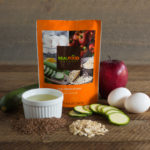
Sources
1 Gungabissoon U, Hacquoil K, Bains C, et al. Prevalence, risk factors, clinical consequences, and treatment of enteral feed intolerance during critical illness. JPEN J Parenter Enteral Nutr. 2015;39(4):441-448. https://doi.org/10.1177/0148607114526450
2 Wang K, Mellroy K, Plank LD, et al. Prevalence, outcomes, and management of enteral tube feeding intolerance: a retrospective cohort study in a tertiary center. JPEN J Parenter Enteral Nutr. 2017;41(6):959-967. https://doi.org/10.1177/0148607115627142
3 Blaser AR, Starkopf J, Kirsimagi U, et al. Definition, prevalence, and outcome of feeding intolerance in intensive care: a systematic review and meta-analysis. Acta Anaesthesiol Scand. 2014;58(8):914-922. https://doi.org/10.1111/aas.12302
4 Batsis ID, Davis L, Prichett L, et al. Efficacy and Tolerance of Blended Diets in Children Receiving Gastrostomy Feeds. Nutr Clin Pract, 2019;00:1-7.
5 Brown B, Roehl K, Betz M. Enteral Nutrition Formula Selection: Current Evidence and Implications for Practice. Nutr Clin Pract. 2015;30(1):72-85.
6 Escuro A and Hummell AC. Enteral Formulas in Nutrition Support Practice: Is There a Better Choice for Your Patient? Nutr Clin Pract. 2016;31(6):709-722.
7 Tiengou LE, Gloro R, Pouzoulet J, et al. Semi-elemental formula or polymeric formula: is there a better choice for enteral nutrition in acute pancreatitis? Randomized comparative study. JPEN J Parenter Enteral Nutr. 2006;30(1):1-5.
8 Taylor AL, Dunstan JA, Prescott SL. Probiotic supplementation for the first 6 months of life fails to reduce the risk of atopic dermatitis and increases the risk of allergen sensitization in high-risk children; a randomized controlled trial. J Allergy Clin Immunol. 2007;119(1):184-191.
9 Mundi M, Velapati S, Kuchkuntla A, et al. Reduction in Healthcare Utilization With Transition to Peptide-Based Diets in Intolerant Home Enteral Nutrition Patients. Nutr Clin Pract. 2020;35(3):487-494.
10 Hron B, Fishman E, Lurie M, et al. Health Outcomes and Quality of Life Indices of Children Receiving Blenderized Feeds via Enteral Tube. J Pediatr. 2019;1.7.
11 Gallagher K, Flint A, Mouzaki M, et al. Blenderized Enteral Nutrition diet Study: Feasibility, Clinical, and Microbiome Outcomes of Providing Blenderized Feeds Through a Gastric Tube in a Medically Complex Pediatric Population. 2018;42(6):1046-1060.
About the author

April Jackson, MS, RD, LDN, CNSC is a Registered Dietitian with 20 years of experience in nutrition support. She is currently a Business Development Manager for Real Food Blends.
Tube Feeding and Constipation

Tube Feeding and Constipation
Preventing and treating one of the most common side effects of tube-feeding
by April Jackson, MS, RD, LDN, CNSC
Talking about bowel habits can be uncomfortable (no pun intended!), but it’s one of the most common side effects of tube-feeding. Nutrition and gut health are closely linked and you can’t really talk about bowel health without discussing the quality of your diet. It’s a fact of tube-feeding life: Regularity is something that many people with feeding tubes struggle with and it can have a direct impact on overall health and quality of life.
What is Classified as Constipation?
Constipation refers to irregularity with the number and frequency of bowel movements. Symptoms include stools that are hard, dry, and difficult to pass and can be associated with straining or pain during passage. In general, if you’re having less than 3 bowel movements per week or going more than 3 days without a bowel movement, you should discuss constipation with your medical provider.
What Causes Constipation?
In general, there are a number of causes of constipation, many of which come into play when someone with a feeding tube is fed a formula-only diet:
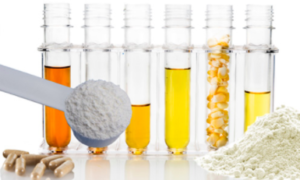
2. Low fiber intake. Fiber adds bulk to stool and absorbs water from the intestines, making stools softer and easier to pass. Diets low in fiber reduce the amount of undigested food in the intestines, which leads to less stool output. Many conventional tube feeding formulas do not contain fiber or the fiber content varies greatly in type and amount. While commercial formulas with added (processed or synthetic) fiber are available, they have been shown to provide little help in treating constipation for most individuals, they increase the risk of clogging the feeding tube, and they may decrease the absorption of certain medications.3 4
3. Dehydration. Adequate fluid intake is important in maintaining regularity whether you are drinking by mouth or through your feeding tube. Fluid needs vary based on age, weight, gender, activity level, and even what climate you live in. One of the best ways to check for dehydration is urine color. The goal should be pale yellow urine.
4. Physical Limitations Decreased activity can slow down the movement of stool through the colon and causes an incomplete emptying of the bowels. This gives the body more time to absorb water out of the stool, leading to constipation. People who are bedridden or immobile typically eat less because they aren’t burning calories through activity. This also leads to longer times between bowel movements, which can also lead to constipation. People with low muscle tone, neuromuscular problems, and/or developmental delays are especially at risk of constipation.
5. Medications and supplements. Several types of medications and supplements can cause constipation. Some, like those containing aluminum and calcium, may interfere with important muscle contractions in the gut. Certain medications used to treat epilepsy, muscle spasms, and pain can also impact these muscle contractions by sending mixed signals to the gut. Diuretics can lead to dehydration (which we know is another cause of constipation). When it comes to supplements, synthetic forms of iron and zinc can lead to or exacerbate constipation, and are added to every tube-feeding formula on the market.5 [Note: Real Food Blends meals have no synthetic vitamins or minerals.]
Preventing and Relieving Constipation
If an oral-eating person complained to their doctor or medical team about constipation issues, the first questions would be: “Are you eating enough fruits and vegetables? Whole grains? Getting enough water?” Before considering adding medications for constipation, people with feeding tubes should first look at their nutrition and hydration.
Think Food First. There are a whole host of benefits from incorporating real food into your tube feeding diet. Research shows that blenderized diets can improve common GI intolerance symptoms associated with commercial formula use, including decreasing nausea and vomiting, diarrhea, reflux and constipation.2 6 7 Soluble and insoluble fibers from fruits, veggies, and whole grains have been shown to improve constipation and diarrhea in people with feeding tubes.6 2 The recommended daily intake for fiber is 14 grams per 1000 calories, which is about 25 grams per day for most women and 38 grams per day for men.1 [Each Real Food Blends meal contains 2-6 g of fiber and includes a fruit, vegetable, and whole grain or healthy starch.] Aside from the numeric fiber goals, remember that fiber quality matters! The synthetic or processed fibers added to most tube-feeding formulas may not be handled in the body the same way as the fibers from the whole foods. Just because you may be hitting a daily fiber goal from formula shouldn’t rule out that fiber still might be a contributing to constipation.
Real food can also help with constipation caused by synthetic iron supplements commonly added to formula–iron from whole food sources is generally better tolerated and results in less GI discomfort. Iron from red meat, poultry, and fish is well absorbed by the body and combining those with foods rich in vitamin C (like orange juice, kale, spinach, and sweet potatoes) increases the absorption of iron even more. [Each Real Food Blends meals contains a high quality lean protein and vitamin C rich fruits or veggies.]
Hydrate. Additional fluids are recommended with tube feedings and especially with blenderized diets, just like oral eaters are encouraged to drink eight 8 ounce glasses of water per day. These fluids can be given as additional flushes before, after, and in between feedings. [Consult your medical team for fluid recommendation for your specific needs.] Water is the typical fluid of choice, and flushing with warm liquids may help stimulate a bowel movement. (Concerned about volume intolerance? Learn more about free water and volume tolerance here.)
Using juice as an additional fluid can also help with constipation. Juices contain sorbitol, a sugar alcohol known for its natural laxative effects, and soluble fiber, which provide a fuel source for good bacteria in the gut. Prune, cherry, pear, and apple juice in particular contain high levels of sorbitol. A good starting point is flushing with 4-8 oz of prune juice daily (2-4 oz for kids) if you are experiencing constipation.8
Get moving. Increasing activity helps to speed up the movement of food through the intestines. This means that there is less time for the body to absorb fluid from the stool, making it easier to pass. Although some people with feeding tubes may be limited in the physical activity they are able to do, the Physical Guidelines for Americans state that “some physical activity is better than none, and adults who participate in any amount of physical activity gain some health benefits.”9 Consult your medical provider before starting any exercise program.
Add probiotics. Probiotics are live microorganisms that improve overall gut health. They are found in cultured or fermented foods like yogurt, kefir, cottage cheese, sauerkraut, kombucha, pickled vegetables, kimchi, miso, and tempeh. Studies suggest that L. acidophilus and B. bifidum may improve intestinal motility and relieve constipation by reducing the pH of the gut.10 Adding pourable kefir, yogurt, or cottage cheese to your tube feeding diet is an easy way to incorporate added probiotics.
This blog is not intended to be medical advice. Always consult your medical team before making any changes in your tube feeding diet.
Sources
1 U.S. Department of Health and Human Services and U.S. Department of Agriculture. 2015-2020 Dietary Guidelines for Americans. 8th ed. 2015. http://health.gov/dietaryguidelines/2015/guidelines/
2 Hron B, Fishman E, Lurie M, Clarke T, Chin Z, et al. Health Outcomes and Quality of Life Indicies of Children Receiving Blenderized Feeds via Enteral Tube. J of Peds 2019;1-7
3 Malone AM. Enteral formulations. In: Cresci GA, ed. Nutrition Suport for the Critically Ill Patient: A guide to Practice, 2nd ed. Boca Raton, FL: CRC Press; 2015:259-277.
4 Johnson T, Seegmiller S, Epp L, Mundi M. Addressing Frequent Issues of Home Enteral Nutrition Patients. Nutr in Clin Prac 2019;34:186-195.
5Tolkien Z, Stecher L, Mander A, Pereira D, et al. Ferrous Sulfate Supplementation Causes Significant Gastrointestinal Side-Effects in Adults: A Systematic Review and Meta-Analysis. PLoS One. 2015; 10(2): e0117383. Published online 2015 Feb 20.
6 Hurt, R. et al. (2015). Blenderized Tube Feeding Use in Adult Home Enteral Nutrition. Nutrition In Clinical Practice, 30, 824-9.
7Batsis ID, Davis L, Prichett L, et al. Efficacy and Tolerance of Blended Diets in Children Receiving Gastrostomy Feeds. Nutr Clin Pract, 2019;00:1-7.
8Bae S. Diets for Constipation. Pediatr Gastroenterol Hepatol Nutr. 2014 Dec; 17(4): 203–208. Published online 2014 Dec 31. doi: 10.5223/pghn.2014.17.
9U.S. Department of Health and Human Services and U.S. Department of Agriculture. Physical Activity Guidelines for Americans. 2nd Edition. 2018. Available at https://health.gov/sites/default/files/2019-09/Physical_Activity_Guidelines_2nd_edition.pdf
10 Kopp-Hoolihan L. Prophylactic and therapeutic uses of probiotics: A review. Journal of The American Dietetic Association 2001;101:229-241
About the author

April Jackson, MS, RD, LDN, CNSC is a Registered Dietitian with 20 years of experience in nutrition support. She is currently a Business Development Manager for Real Food Blends.
The Role of Real Food in Tube Weaning

The Role of Real Food in Tube Weaning
Research supports increased interest in oral eating with blenderized diets

“My child is now eating Real Food Blends orally!”
This is a comment we get quite a bit and might be one of our very favorite “side effects” of using Real Food Blends in place of a typical tube-feeding formula. Aside from the anecdotal evidence we hear time and again, many of the studies about real food for people with feeding tubes note this “increased interest in oral eating.” Below, Aubrey Phelps, MS, RDN, PPCES, IFNCP, goes over different studies that show how using real food can help facilitate the transition to eating orally and what the results mean outside of a clinical setting. She also has personal experience with this topic—her daughter was able to transition from using Real Food Blends with her feeding tube to 100% oral eating!
by Aubrey Phelps, MS RDN, PPCES, IFNCP
Getting your child with a feeding tube to happily become an oral eater can seem like a monumental task. There are many factors that go into a successful tube-wean, but one often-overlooked aspect to tube-weaning is that introducing food through the tube prior to starting a wean can increase the chances of success. Aside from anecdotal evidence (including my own daughter!), two independent research studies have noted this impact:
“The parents of 17 of 33 children (52%) reported a 76% to 100% decrease in gagging and retching after their child started the PBGT diet… No parents reported that their child’s gagging or retching worsened on the PBGT diet”
“Nineteen children (57%) were reported to have an increase in oral intake on the pureed by gastrostomy tube (PBGT) diet… No child was reported to eat less by mouth after starting the PBGT diet”
“The decrease in gagging and retching on puréed feeds may have decreased oral aversion, making the child more receptive to eating by mouth”

Puree by gastrostomy tube diet improves gagging and retching in children with fundoplication
Pentiuk et al (2011) – Cincinnati Children’s Hospital Medical Center
This study looked at the use of purees through the g-tube, specifically for kids. To summarize the key take-aways quoted above, switching to a pureed real food diet improved reflux and retching in over half of the kids—this is one of the most common reported frustrations of parents with children using a tube and a prime reason for a switch to a J-tube. For that group, improvement was significant, ranging from almost completely stopping reflux and retching to being totally eliminated. And none of the kids had worsened symptoms when they switched. In other words, there’s a great chance switching to a blenderized/real food puree diet could improve your child’s vomiting and gagging and very little chance it could make things any worse (so you don’t really have anything to lose!).
This study also concluded that oral intake improved with a pureed tube-fed diet and that this improvement was likely thanks to the reduction in digestive discomfort. Because oral aversions are a huge contributor to tube-feeding and an obstacle to improving oral intake for a wean, this approach to tube-feeding may help lead the way to weaning or increasing oral intake as appropriate to the individual’s medical needs.
“Parents reported less limitation to food and drink intake with blenderized diets. This may reflect improved gastrointestinal tolerance of dietary components, increased perception of diversity of diet, or increased oral intake, as suggested by Gallagher et al”

Health outcomes and quality of life indices of children receiving blenderized feeds via enteral tube
Horn et al (2019) – Boston Children’s Hospital
And yet again, this study found that kids simply did better on blenderized diets, from a comfort standpoint, as well as oral intake. (If you are on the fence about trailing a blended diet like Real Food Blends, I would highly encourage you to read this entire study. It’s the largest done to date on blended diets and is a head-to-head comparison of formula-fed children to children fed real food. No surprise, those getting a wide variety of fruits & veggies fared much better!)
Why Does Real Food Often Increase Interest in Oral Eating?
Exactly why getting a variety of real food into the stomach through the tube seems to create this willingness to eat orally is debated. Improvements in reflux, vomiting, constipation/diarrhea, and lowering or eliminating medications to manage all these symptoms can all contribute to increased in eating orally. After all, who would want to eat if they feel sick or uncomfortable all the time?
It could also be from improvements in the gut microbiome, as one of the studies above supported. Each type of bacteria in your gut has a preference for certain kinds of foods–the “good guys” really, really like fiber, fruits, and vegetables. A real food diet encourages the growth of more of these good bacteria, which in turn, encourages a desire for more of the food that they like! Less healthy microbes prefer processed carbs/sugars, which most commercial tube-feeding formulas are quite high in. Improvement in microbiome balance also supports a happier digestive system, which can improve both digestion and immune health (and doesn’t it make sense that a kid who’s no longer sick all the time might have more interest in eating?). It’s important to note that in all these studies, the children were fed a varied, whole food diet exposing their bodies to a wide variety of food, smells, and ‘tastes.’
With all of these potential gains, there are really no reasons to NOT trial a blenderized diet like Real Food Blends if your child is over the age of 1 and has an intact and working digestive system. Even if it doesn’t increase oral intake, it will likely improve digestive comfort and will have a positive impact on the microbiome, which supports overall improved health! (And there’s a growing body of clinical support from major medical institutions showing that real food is good for kids – go figure!)
About the author

Aubrey Phelps, MS, RDN, PPCES, IFNCP is a registered integrative nutritionist specializing in perinatal and pediatric nutrition. She’s a momma to a former tubie who thrived on Real Food Blends before she weaned to a diverse, real food oral diet! Outside of her private practice, Aubrey consults for Growing Independent Eaters, a home-based tube-weaning program, as well as Real Food Blends.
Additional Information on Tube Weaning
Learn more about how real food through the feeding tube can help with the tube weaning process in this video from Marsha Dunn Klein, a pediatric occupational therapist who has spent a career specializing in pediatric feeding challenges.
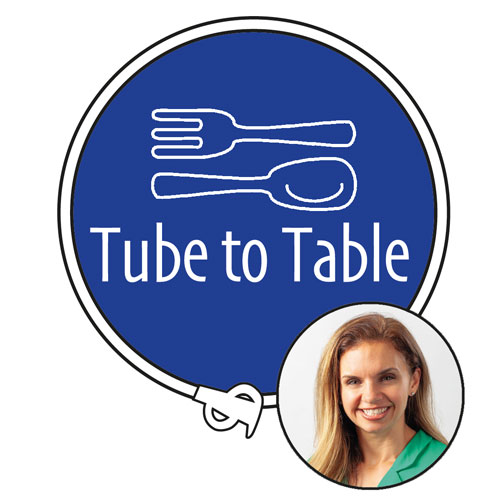
Listen to our co-founder, Julie Bombacino, talk about the role of real food in tube weaning on the Tube to Table podcast from Thrive by Spectrum Pediatrics.



